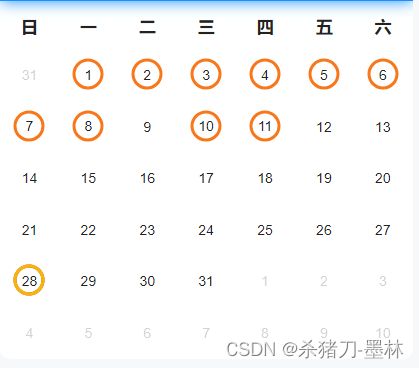momentJs推导日历组件
实现效果:
代码:
引入momentjs然后封装两个函数构建出基本数据结构
import moment from 'moment';
// 某月有多少天
export const getEndDay = (m) => m.daysInMonth();
/**
* @description 获取本月空值数据
* @param { Date } year { } 年度
* @param { Number } month 月份
* @param { Date } current moment当天日期
*/
export const getCalendar = ({ year, month, current }) => {
// 最多6行, 每行为一周7天
const totalDays = 7 * 6;
// 获取这个月第一天具体日期
const start = new Date(year, month - 1, 1);
let lastEndDay = [];
// 上个月的天数
const lastDays = getEndDay(current.clone().subtract(1, 'month'));
// 当前月的天数
const nowDays = getEndDay(current);
const currentDays = [...(new Array(nowDays))].map((v, i) => ({
day: i + 1,
})).map((v) => {
const currentDate = v.day >= 10 ? `${moment(current).format('YYYY-MM')}-${v.day}` : `${moment(current).format('YYYY-MM')}-0${v.day}`;
return {
day: v.day,
denyTime: moment().valueOf() > moment(`${currentDate} 23:59:59`).valueOf(),
currentDate,
};
});
if (start.getDay() === 0) {
// 这个月1号为周日,则取上个月最后6天
lastEndDay = [...new Array(lastDays)].map((v, i) => i + 1).filter((v) => v > lastDays - 6).map((v) => ({
day: v,
denyMonth: true,
}));
} else {
lastEndDay = [...(new Array(lastDays))].map((v, i) => i + 1).filter((v, i) => i > lastDays - start.getDay()).map((v) => ({
day: v,
denyMonth: true,
}));
}
// 获取下个月补充天数
const nextDays = [...new Array(totalDays - lastEndDay.length - currentDays.length)].map((v, i) => ({ day: i + 1, denyMonth: true }));
const data = [...lastEndDay, ...currentDays, ...nextDays];
return data;
};页面代码部分:
{{ renderCalendarMonth }}
上个月
本月
下个月
{{ item }}
{{ item.day }}
import moment from 'moment';
import { getCalendar } from '../request';
export default {
data() {
return {
weekLabel: ['一', '二', '三', '四', '五', '六', '七'],
// 当前时间日历推导
currentTime: moment(),
// 日历挂表
CalendarDays: [],
// 选择日期
activeDay: moment().format('yyyy-MM-DD'),
// 月份切换
activeMonth: 0,
};
},
computed: {
// 日历具体年月份
renderCalendarMonth() {
const enumMonth = ['一', '二', '三', '四', '五', '六', '七', '八', '九', '十', '十一', '十二'];
const year = moment().subtract(this.activeMonth, 'months').format('yyyy');
let month = moment().subtract(this.activeMonth, 'months').format('M');
month = enumMonth[month - 1];
return `${year}年${month}月`;
},
},
created() {
this.init();
},
methods: {
// 初始化
init() {
this.CalendarDays = getCalendar({
year: moment().format('yyyy'), current: this.currentTime, month: moment().format('M'),
});
},
// 月份切换
handleMonth(type) {
if (type) {
if (type === 1) {
this.activeMonth++;
} else {
this.activeMonth--;
}
const day = moment().subtract(this.activeMonth, 'months');
this.CalendarDays = getCalendar({
year: day.format('yyyy'),
current: day,
month: day.format('M'),
});
} else {
this.activeMonth = 0;
this.CalendarDays = getCalendar({
year: moment().format('yyyy'), current: this.currentTime, month: moment().format('M'),
});
this.activeDay = moment().format('yyyy-MM-DD');
}
},
handleDay(item) {
if (item.denyMonth || item.denyTime) return;
this.activeDay = item.currentDate;
},
},
};
结尾:这里贴代码就挺难受的,没有Vue只有html,果然这个时候用react就不错,不过思路已经提供了,先理清日历的每周对应天数结构,后面处理起来就容易许多。这里附上做的另一个日历效果图,代码就不贴了,js推导函数都差不多,不过是把日期天数的推导改下就可以了。

